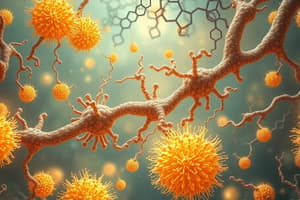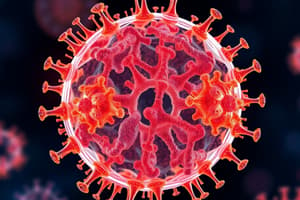Podcast
Questions and Answers
Which statement correctly defines metabolism?
Which statement correctly defines metabolism?
- Metabolism is the sum of all chemical reactions in an organism. (correct)
- Metabolism does not involve energy changes.
- Metabolism is limited to catabolic reactions.
- Metabolism only includes anabolic reactions.
How do enzymes affect the activation energy of a reaction?
How do enzymes affect the activation energy of a reaction?
- Enzymes convert activation energy into heat.
- Enzymes lower the activation energy needed for a reaction. (correct)
- Enzymes increase the activation energy required.
- Enzymes have no effect on activation energy.
What is the main outcome of glycolysis?
What is the main outcome of glycolysis?
- It synthesizes glucose from pyruvate.
- It generates carbon dioxide and water.
- It produces ATP, NADH, and pyruvate. (correct)
- It produces lactic acid only.
Which process is primarily associated with anaerobic respiration?
Which process is primarily associated with anaerobic respiration?
What distinguishes aerobic respiration from anaerobic respiration?
What distinguishes aerobic respiration from anaerobic respiration?
What role does ATP play in cellular processes?
What role does ATP play in cellular processes?
Which of the following involves the conversion of light energy into chemical energy?
Which of the following involves the conversion of light energy into chemical energy?
In the Krebs cycle, what is the primary input that initiates the cycle?
In the Krebs cycle, what is the primary input that initiates the cycle?
What are the final products of the electron transport chain?
What are the final products of the electron transport chain?
Which statement correctly describes fermentation?
Which statement correctly describes fermentation?
What is the primary purpose of transcription in cells?
What is the primary purpose of transcription in cells?
Which type of mutation results in a change of a single nucleotide in the DNA sequence?
Which type of mutation results in a change of a single nucleotide in the DNA sequence?
How does bacterial conjugation primarily occur?
How does bacterial conjugation primarily occur?
What is required for bacterial transformation to take place?
What is required for bacterial transformation to take place?
Which component of the genetic code is recognized by tRNA during translation?
Which component of the genetic code is recognized by tRNA during translation?
What role do transposons play in microorganisms?
What role do transposons play in microorganisms?
In what way is the genetic material organized differently in prokaryotes compared to eukaryotes?
In what way is the genetic material organized differently in prokaryotes compared to eukaryotes?
What are the three main types of bacterial recombination?
What are the three main types of bacterial recombination?
Which statement best describes the relationship between DNA structure and genetic expression?
Which statement best describes the relationship between DNA structure and genetic expression?
What is the significance of nitrogenous bases in DNA?
What is the significance of nitrogenous bases in DNA?
What is the primary role of enzymes in cellular metabolism?
What is the primary role of enzymes in cellular metabolism?
Which of the following best describes glycolysis?
Which of the following best describes glycolysis?
What is the main outcome of the Krebs cycle?
What is the main outcome of the Krebs cycle?
Which characteristic is NOT associated with enzymes?
Which characteristic is NOT associated with enzymes?
What process converts light energy into chemical energy?
What process converts light energy into chemical energy?
In which part of the cell does the Krebs cycle primarily take place?
In which part of the cell does the Krebs cycle primarily take place?
What are the end products of fermentation in anaerobic organisms?
What are the end products of fermentation in anaerobic organisms?
What best describes the electron transport chain's function?
What best describes the electron transport chain's function?
How does anaerobic respiration differ from aerobic respiration?
How does anaerobic respiration differ from aerobic respiration?
What is the primary role of ATP in cellular processes?
What is the primary role of ATP in cellular processes?
What does the term 'genotype' refer to in genetics?
What does the term 'genotype' refer to in genetics?
Which process describes the movement of genetic material via bacteriophages in bacteria?
Which process describes the movement of genetic material via bacteriophages in bacteria?
How is the structure of DNA most commonly described?
How is the structure of DNA most commonly described?
What is a key characteristic of bacterial transformation?
What is a key characteristic of bacterial transformation?
Which of the following best explains the role of codons in protein synthesis?
Which of the following best explains the role of codons in protein synthesis?
What is the primary function of transposons in microorganisms?
What is the primary function of transposons in microorganisms?
What is the significance of the chemical structure of DNA?
What is the significance of the chemical structure of DNA?
Which event occurs during the process of transcription?
Which event occurs during the process of transcription?
In which type of cells is the process of translation primarily located?
In which type of cells is the process of translation primarily located?
What does the term 'phenotype' encompass in genetics?
What does the term 'phenotype' encompass in genetics?
Flashcards
Metabolism types
Metabolism types
Metabolism is the sum of all chemical reactions in an organism. It includes anabolic reactions (building up molecules) and catabolic reactions (breaking down molecules).
Enzyme function
Enzyme function
Enzymes are biological catalysts that speed up chemical reactions without being consumed in the process.
Enzyme structure
Enzyme structure
Enzymes have a specific 3D shape that allows them to bind to specific substrates, promoting chemical reactions.
Glycolysis
Glycolysis
Signup and view all the flashcards
Krebs cycle
Krebs cycle
Signup and view all the flashcards
Cellular Respiration (Aerobic)
Cellular Respiration (Aerobic)
Signup and view all the flashcards
Fermentation
Fermentation
Signup and view all the flashcards
Photosynthesis
Photosynthesis
Signup and view all the flashcards
DNA structure
DNA structure
Signup and view all the flashcards
DNA Replication
DNA Replication
Signup and view all the flashcards
Transcription
Transcription
Signup and view all the flashcards
Translation
Translation
Signup and view all the flashcards
Bacterial Operon
Bacterial Operon
Signup and view all the flashcards
Mutation
Mutation
Signup and view all the flashcards
Bacterial Recombination
Bacterial Recombination
Signup and view all the flashcards
Conjugation
Conjugation
Signup and view all the flashcards
Transformation
Transformation
Signup and view all the flashcards
Transduction
Transduction
Signup and view all the flashcards
Transposons
Transposons
Signup and view all the flashcards
Heredity
Heredity
Signup and view all the flashcards
Genetics
Genetics
Signup and view all the flashcards
Genome
Genome
Signup and view all the flashcards
Gene
Gene
Signup and view all the flashcards
Phenotype
Phenotype
Signup and view all the flashcards
Genotype
Genotype
Signup and view all the flashcards
Anabolic Reactions
Anabolic Reactions
Signup and view all the flashcards
Catabolic Reactions
Catabolic Reactions
Signup and view all the flashcards
Active Site
Active Site
Signup and view all the flashcards
ATP: Energy Currency
ATP: Energy Currency
Signup and view all the flashcards
Glycolysis: Sugar Breakdown
Glycolysis: Sugar Breakdown
Signup and view all the flashcards
Krebs Cycle: Citric Acid Cycle
Krebs Cycle: Citric Acid Cycle
Signup and view all the flashcards
Electron Transport Chain
Electron Transport Chain
Signup and view all the flashcards
Fermentation: Anaerobic Energy
Fermentation: Anaerobic Energy
Signup and view all the flashcards
Photosynthesis: Light to Energy
Photosynthesis: Light to Energy
Signup and view all the flashcards
Study Notes
Chapter 8: Introduction to Microbial Metabolism
- Metabolism is the anabolic and catabolic reactions performed by microorganisms.
- Enzymes' structure, function, and control mechanisms are examined.
- Cellular respiration pathways (glycolysis, Krebs cycle, electron transport) are reviewed.
- Fermentation in anaerobic environments, photosynthesis, and macromolecule formation are discussed.
- Efficiency of microorganisms is highlighted.
Expected Learning Outcomes (Chapter 8)
- Define metabolism and differentiate its types.
- Describe enzyme functions and characteristics.
- Explain how enzymes lower activation energy and relate them to substrates.
- Describe enzyme types and naming methods.
- Explain energy sources and cellular energy management.
- Discuss biological redox reactions and energy transfer.
- Explain ATP structure and function.
- Detail catabolic pathways in aerobic respiration.
- Explain glycolysis (input, output, steps, and connection to Krebs cycle and oxidative phosphorylation).
- Explain the Krebs cycle (input, output, steps, and connection to oxidative phosphorylation).
- Summarize aerobic respiration.
- Describe anaerobic respiration reactions.
- Define and elaborate on fermentation and its roles.
- Detail fermentation processes and products.
- Explain photosynthesis's reactions and significance.
Chapter 9: Microbial Genetics
- Introduces the study of genetics.
- DNA structure is reviewed and genes are introduced.
- DNA replication, fidelity, transcription, and translation processes are discussed.
- Gene expression in both prokaryotic and eukaryotic cells is covered.
- Bacterial operons, mutations, and mutation types are explained.
- Bacterial recombination (conjugation, transformation, and transduction) are presented.
- Transposons are introduced.
Expected Learning Outcomes (Chapter 9)
- Define heredity, genetics, genome, gene, phenotype, and genotype.
- Compare genetic material (bacteria, eukaryotes, viruses).
- Explain DNA organization and packaging.
- Describe DNA chemical structure and significance.
- List and describe nitrogenous bases and bonding patterns.
- Describe DNA replication in prokaryotic cells.
- Explain the flow of genetic information in cells.
- Explain the relationship between DNA structure and genetic expression.
- Explain major transcription events.
- Relate the genetic code, codons, anticodons.
- Explain the processes in protein synthesis (translation).
- Explain recombination in bacteria.
- Describe and explain conjugation, transformation, and transduction.
- Discuss transposons and their importance.
Studying That Suits You
Use AI to generate personalized quizzes and flashcards to suit your learning preferences.




